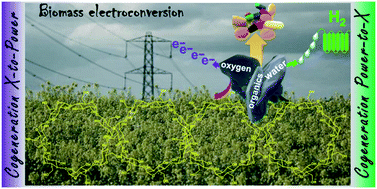Recent advances in the electrooxidation of biomass-based organic molecules for energy, chemicals and hydrogen production
Abstract
Electrosynthesis, a historically powerful tool for the production of a number of industrial-scale inorganic or organic materials, has experienced a renaissance over the last ten years with research efforts seeking a dual production platform for molecules and energy carriers. It is termed a “Power-to-X” approach. Specifically, hydrogen (H2) is a key compound in emerging energy conversion and storage systems, acting as an energy carrier to provide electrical energy with a significantly reduced environmental footprint through H2/O2 fuel cells. The clean energy production strategy from energy carriers is inversely termed an “X-to-Power” approach. However, H2 sources remain up to now the main key challenge. Increasing interest surrounds the development of advanced low energy consumption electrolysis cells enabling reliable, sustainable and dual production of both H2 and valuable chemicals from the selective oxidation of surplus biomass-derivatives. It can thus be summed up that the tremendous idea of generating electricity or producing fuels such as H2 while synthesizing chemicals is an attractive pathway for organic synthesis and electricity production. However, precisely how this could be achieved in a cheap and sustainable way remains a puzzle for scientists. However, organics selective electrooxidation reactions are central topics and bridge fuel cell and electrolysis cell research. A number of (bio)catalytic interfaces have been developed to overcome their sluggish electrochemical kinetics. Within this perspective, we propose a detailed review on the recent advances over the last ten years in co-generative fuel cells and electrolysis cells that operate with biomass-based organic molecules (ethanol, ethylene glycol, glycerol, (oligo)saccharides, cellulose, hemicellulose) while highlighting experimental and theoretical research that unifies those fields to yield devices with improved performance. The identified main electrocatalytic reaction descriptors allow for new materials to be proposed, which could enable maximized activity, selectivity and durability of anode materials. This perspective particularly enlightens the missing fundamental knowledge on parameters dictating electrocatalysis of organic compounds in aqueous media. Overall, we discuss the implications for the wider scientific community of electrochemistry, electrocatalysis, materials science and organic chemistry, and finally provide several logical pathways and guidelines to stimulate progress, inspiring the development of organic-fuelled cogeneration electrochemical devices.



 Please wait while we load your content...
Please wait while we load your content...